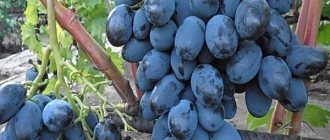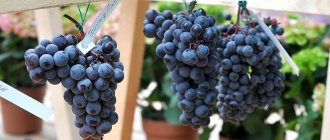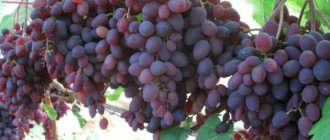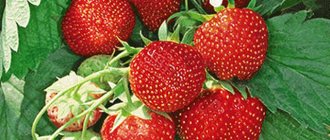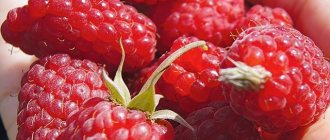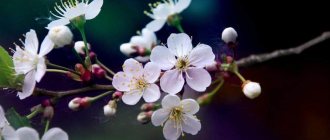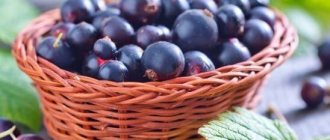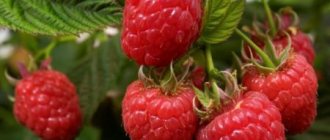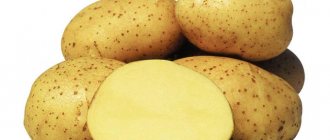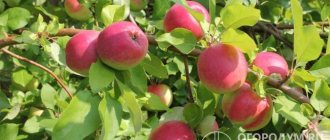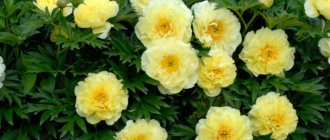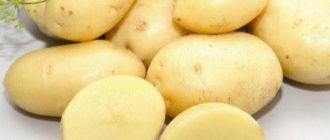Origin of the variety
Mukuzani is called a variety of folk selection, since there is no information about any work on its breeding. The variety was discovered by chance in a Georgian village of the same name. Cultivated grapes today are popular in the north and central Russia.
Did you know? According to legend, Saint Nino, who brought the Christian faith to Georgia, came with her good news, carrying in her hands a cross woven from a grape vine and tied in the middle with her hair.
What will the wine be like?
The fruits of Mukuzani make excellent dry wine. Its taste is reminiscent of Saperavi. Spicy, rich taste, with hints of fruity chocolate. When pouring such an exquisite ruby-colored drink, you can feel a pleasant light aroma. Experts say that wine made from Mukuzani fruits leaves a slightly tart aftertaste with an imperceptible bitterness. If you age the wine according to all the rules and laws of winemaking, a berry tint appears. It can be compared to blackberries or red currants. The longer the wine is stored, the more aroma it develops, the taste changes dramatically: the sourness inherent in young wine disappears, and at the same time it becomes soft. The aroma is so strong that it stays on the glass for at least two or three hours.
Water is often added when aging and making wine. If you don’t do this, the wine turns out to be quite viscous and thick. The taste is harmonious and velvety.
Description of the Mukuzani grape variety
Grapes are used not only as a fruit crop, but also to decorate terraces or gazebos, directing the growth of the vine in the desired direction.
Characteristics of bushes
The vine grows quickly, forming several branches with its own fruit shoot. Each ripening shoot forms 2–3 fruit clusters. The bush is leafy, the foliage is large, light green. The leaf plate is divided into three or five blades with a carved edge.
Productivity
One adult bush, with proper care, produces 40–50 kg of harvest. The fruits tolerate transportation well.
Bunches and berries
The cone-shaped bunch is tightly knit, up to 30 cm long. The berries are small, round, weighing up to 3 g. The taste is pleasant, slightly tart, sweet and sour. Sugar content up to 22%. The color of the fruit is inky, the thick skin is covered with purine, and contains about 3 seeds. The berries are juicy, which makes them an ideal raw material for making wine or juice.
Important! Inexperienced buyers believe that the famous wine of the same name is produced from the Mukuzani variety. This is not true, it is produced from Saperavi grapes.
When to harvest mukuzani?
Judging by the reviews of winemakers, there are no clear dates for picking fruits. You can check the berries using a refractometer. The ripening of the bunch is checked by tasting the grapes - juicy, sweet pulp is a sign of readiness to harvest.
The transformation of the berries into raisins, drying out, changing color to black is a sign that the grapes are overexposed and have begun to deteriorate. A distinctive feature of the taste of ripe berries is the absence of characteristic astringency and a nightshade aftertaste.
There are no specific harvest dates for this variety. Many gardeners and winemakers use a refractometer. You can also look for changes in the taste and color of the fruit. If you think that the fruit is fully ripe, then you need to taste one berry. The pulp should be juicy. The taste of the fruit should not be tart or the berry should not turn into raisins.
Some gardeners grow this variety for fresh consumption. The taste of the fruit is superior to such varieties as: Isabella, Marquette or Saint Pepin. Collect ripe fruits in wooden or plastic baskets. It is recommended to immediately after collection be consumed or prepared into various preserves and jams. The remaining fruits are best stored in a ventilated area.
Advantages and disadvantages
Mukuzani is considered a wild species, which is what gives the culture enormous potential for resilience. The plant, unlike pampered cultivated varieties, has amazing immunity and resists bad weather conditions and pests.
- Other advantages:
- good transportability;
- friendly ripening of berries;
- resistance to major crop diseases;
- frost resistance;
- fruit juiciness;
- pleasant taste.
The only drawback is that the shoots grow too quickly, which forces the winegrower to prune more often.
Wine characteristics
This variety is suitable for making dry red wine of the Saperavi type. The product obtained from this variety is characterized by a spicy, rich taste with fruity and chocolate undertones, an intense dark ruby color and a light aroma. Some winemakers describe its aftertaste as tart or slightly bitter. The acidity of the product is average (the figure given is 6.3 g per liter).
When aging the wine, a long aftertaste appears with a hint of berries (blackberries, red currants). Long-term storage affects the softening of the taste and the disappearance of sourness. The product becomes balanced in flavor. The aroma becomes stable and remains in the glass for more than two hours.
If you do not dilute the wine with water, it turns out thick and viscous. The taste is harmonious and velvety. Disadvantages include a lack of tannins.
Mukuzani does not require any processing. It is frost-resistant, can withstand temperatures down to -35-38 degrees and is one of the varieties that are not covered in winter. But, in order not to risk the health of the vines, winegrowers prune the plants in the autumn and transfer them from the trellises to the ground, not forgetting to hill up and pin them. This way the plantings will better survive the winter under the snow.
Mukuzani grapes overwinter without shelter
Usually bushes are planted near the walls of buildings and gazebos. Since this is a high-yielding variety, planting requires rationing. This is necessary so that the plants do not become overloaded, the quality of the fruit does not drop, and the frost resistance of the bushes does not decrease.
To determine the harvest date, a refractometer is used. It is also possible to focus on changes in the taste of berries. If the nightshade taste has disappeared, then the fruits are ready to be harvested.
Winegrowers in central Russia recommend using the high-yielding variety “mukuzani” for home-made wines and juices. It is assessed as superior in technical characteristics to other varieties (the famous Isabella) and is recognized as equal to Frontignac, Marquette or Saint Pepin. It is also used for decorative purposes.
Recently, a variety of industrial grapes has spread in Russia, well adapted to the weather conditions of the middle zone. This variety is popularly called Mukuzani. Winemakers claim that only from such varieties can wine with unique properties be obtained.
Features of planting at home
The best time to plant grapes is spring; in this case, the bush will produce its first harvest the following year. When planted in autumn, fruiting will begin no earlier than two seasons later.
Selecting a location
The key to success when growing grapes is a correctly chosen place open to the sun. The ideal option is a slope facing south, well ventilated. Considering the long root system of the crop, the occurrence of groundwater is preferably 2.5 m below the soil surface.
Good predecessors for sunny berries:
- melons;
- radish;
- carrot;
- zucchini;
- cultivated cereals.
Important! You should not plant the vine next to sage and perennial colored peas: these plants inhibit the crop.
Preparing for landing
The ideal soil for the crop is chernozem; in the absence of it, sandstones and loams are suitable. If the composition is too acidic, add lime. 2 weeks before the procedure, the area is dug up, cleared of plant debris, and 4–5 kg of humus per m² is added.
Prepare a trench for the holes in advance:
- direction - from north to south;
- width - meter;
- depth - 80 cm.
Technical grape varieties also include Solaris, Black Pearl, Rkatsiteli, Amethyst, and Shiraz.
Planting scheme
Own seedlings, waiting in the wings since autumn, stop watering within a few days.
Planting technology:
- 80x80 holes are dug in the trench and drainage is placed at the bottom.
- A mound of earth is poured on top.
- A seedling is placed on it, the roots are straightened and sprinkled with soil.
- The seedling must be buried to the 2nd bud.
- The soil is compacted and watered with 20 liters of water.
- The soil around the trunk is covered with mulch.
Landing
Let's find out which place is best to choose for rooting this grape variety, and how to plant the plant correctly.
Site selection, preparation
It is recommended to plant the plant near supporting structures: walls of buildings, gazebos, sleepers. Then, as the grapes grow, they will beautifully twine around vertical structures.
The soil in the area intended for planting Mukuzani seedlings must have neutral acidity. This is an important condition, since the soil is acidified and the harvest will be sour and tasteless. If the soil does not meet this requirement, add lime or chalk to it ahead of time; dolomite flour is also suitable.
It is important that the soil is sufficiently nutritious. Add minerals and organic matter.
- the bed is dug up;
- weeds are removed;
- if necessary, disinfection is carried out;
- fertilizers are applied.
The best time for rooting Mukuzani grapes is a warm, sunny day. It is better to plant in spring. If several bushes are planted, it is better to dig not individual holes, but a common trench. But it is necessary to maintain distance between plants.
Procedure
- A couple of days before planting, grape seedlings must stop watering. This contributes to the formation of an earthen coma near the roots.
- In the garden bed I dig a hole about 30 cm in diameter and the same depth.
- At the bottom of the recess, drainage made of broken bricks and crushed stone should be placed.
- A fertile layer of soil mixed with sand is poured over the drainage.
- The seedling is placed in a hole on a formed mound.
- The roots are sprinkled with ash.
- The seedling is carefully covered with soil on all sides, compacting it along the way.
- After planting, the seedling needs to be watered well.
Attention: experienced winegrowers advise adding a handful of barley grains when planting in a hole. It is believed that barley helps grape seedlings take root better
Let's get acquainted with the features of caring for Mukuzani grapes and find out all the most important points of this process.
Trimming
This is one of the most important procedures in caring for this grape variety. Pruning is aimed mainly at normalizing the number of bunches. A lot of ovaries are formed on the vine, and if they are all left, the quality of the harvest will greatly decrease. For the purpose of normalization, pruning is carried out in the spring. But first, they carefully inspect the vine, remove frozen shoots and rotted shoots.
In the fall, pruning is also done, but this time it is aimed mainly at maintaining the appearance of the bush and its health.
Weeding
In order for the grapes to develop well and not get sick, it is necessary to promptly remove weeds from the garden beds. This work is especially important when the plant is still young and weak.
Treatment
Grapes can be affected by pests. To protect the plant, it is sprayed with insecticides in the spring. Preventative treatment in this case is mandatory, even if no traces of insects are visible around. Fortunately, wasps do not touch the berries (possibly due to the tart taste of the latter).
Note that this variety is rarely affected by fungal diseases: Mukuzani has genetic resistance to the fungus. However, infection with oidium is likely.
Harvesting
There are no clear dates for harvesting fruits for this variety. Typically, gardeners determine ripeness in the following way: using a refractometer or their own taste sensations. When the grapes are ripe and ready to harvest, they acquire a juicy, sweet taste with a slight tartness. There should be no nightshade taste by this time.
Wintering
To prevent the grapes from freezing in winter, it is recommended to cover them. The procedure is as follows:
- Before covering, pruning is done.
- Then the plant must be covered with earth on all sides.
- The shoots are removed from the trellises and tied up.
- The vine is carefully laid on plywood sheets, covered with burlap and spruce branches on top.
Note that the variety is quite frost-resistant and can withstand significant cold without shelter. But protect the plant if winters are very frosty and have little snow.
Features and rules for caring for Mukuzani grapes
In addition to watering and fertilizing, the vine needs well-groomed soil. Be sure to weed and loosen the soil after each watering.
How often to water grapes
Mukuzani tolerates drought well, but you should not be convinced of this. With stable rainfall, the crop needs only 3-4 waterings. It’s easy to check whether the soil is sufficiently moistened: you need to squeeze a handful of soil in your palm; if it crumples, it means it’s moistened.
In the absence of rain and snow in winter, the soil needs to be moistened more often:
- The first watering is in March and April, up to 30 liters of water per bush. The water should be at room temperature, settled.
- In May, about 3 weeks before flowering, water up to 2 times.
- During the fruiting period, the soil is moistened 2–3 times.
- A week before the start of flowering and during it, you should not water the crop - the flowers may fall off.
Fertilizing
Considering the introduction of organic matter when digging up the land for planting, organic fertilizers are no longer applied for the first 2–3 years. Due to the abundance of nitrogen, the plant may begin to “fatten,” which will have a detrimental effect on fruiting.
The first feeding is needed to grow fruiting shoots.
The following balanced composition is added to the tree trunk circle, dissolved in 10 liters of water:
- ammonium nitrate - 40 g;
- potassium salt - 20 g;
- superphosphate - 15 g.
To stimulate flowering and the formation of fruit ovaries, the bushes are fertilized with the following composition (per 10 liters of water):
- ammonium nitrate - 15 g;
- potassium salt - 20 g.
After a week, 5 g of boric acid is added to the composition.
During the fruiting period, the vine is fertilized with potassium-phosphorus fertilizers, diluting the preparations in water (10 l):
- superphosphate - 40 g;
- potassium magnesia - 20 g.
Preparing the plant for winter
For the winter, the grapes are removed from the support and trimmed, leaving short shoots. The vine is bent to the surface of the soil, tied and pinned to the ground. After this, they spud and cover with spruce branches. After snow falls, it is raked over the pine needles.
In principle, all these manipulations do not need to be carried out, since Mukuzani can withstand 30-degree frost. But winegrowers take out insurance to save their labor.
Pruning and shaping the bush
Mukuzani quickly grows shoots and foliage, so pruning is an inevitable procedure. In the spring, first of all, inspect the bush and remove frostbitten or broken branches. The first manipulation is carried out before the juices begin to flow, while the vine is sleeping.
Learn how to properly prune grapes in spring and fall.
During the flowering period, pinch the tops of the shoots to direct all the nutrients to the inflorescences. In summer, barren shoots with tendrils and excess brushes are removed so as not to overload the bush. Rationing the brushes will give a full, juicy harvest.
During the ripening of the berries, the leaves that block the sunlight are partially removed. In the fall, all lower, unpromising branches are removed. Double and triple lashes are trimmed, rejuvenating the bush.
A little history
It got its name from the Georgian wine “Mukuzani”, which is made from Separavi grapes. This grape appeared in the vastness of Russia quite recently. Its first breeders were Georgian winegrowers. It was found by chance in a small Georgian village in the Kakheti valley. Thanks to its unique qualities, this variety gradually reached the Saratov and Voronezh regions and is confidently moving further to the north.
On a note! Mukuzani grapes have perfectly adapted to the climatic conditions of the middle zone due to the fact that they have an early ripening period. The harvest begins at the end of August.
A wine drink made from this grape is gaining increasing popularity among Russian residents. And although this is a wine grape variety, it is quite sweet and its taste is rich. The specific grape aroma of Mukuzani spreads around the vine from the beginning of flowering until the harvest itself.
Disease and pest control
As already mentioned, the variety is resistant to diseases and pests; grapes and wasps are not damaged. To prevent these and other misfortunes, spring spraying with 1% Bordeaux mixture helps.
Perhaps, due to weather conditions or other external factors, the vine will get sick or be attacked by insects, in this case you need to know control methods:
- Oidium - use the drug "Quadris SK", treatment by spraying. The working solution is prepared in the proportion of 6 ml/5 l of water.
- Mildew - the drug "Alirin-B" is effective, spray with a solution of 2 tablets per liter of water.
- The insectoacaricide “Bi-58 New” is effective against most insects and ticks, as well as their offspring. The drug is applied one sheet at a time in the proportion of 5 ml of the drug per 5 liters of water.
Did you know? In medieval Europe, thorny roses were traditionally planted in front of the grape bush. They did this so that horses grazing anywhere would not eat the crops.
Why Mukuzani is considered a masterpiece of Georgia
Mukuzani appeared in the northern latitudes not so long ago. Its first breeders were Georgians. We found this variety by chance, in one of the Georgian villages not far from the mountain slopes. But do not confuse him with Saperavi. The latter is used to make a wonderful wine called “Mukuzani”. It is because of the name that confusion occurs. Why is this wine variety called unique? The fact is that for wintering the variety does not need to be covered or insulated, as in most cases. It is able to withstand severe frosts. At the same time, the yield does not fall, but, on the contrary, becomes higher. The variety is considered strong, as it can resist many diseases and different types of fungus. True, sometimes, rarely, Mukuzani can suffer from oidium. A very convenient variety for the North due to its short ripening period. Harvesting can be done as early as the end of August. Depending on where it develops, the collection period may extend to early September. To be honest, he did not pass state tests, but his people's love is spreading further and further. And the wine drink is famous in all corners of the country. This hybrid successfully combines Georgian wine varieties. It is moderately sweet and not very sour, and the aroma flows already during flowering and until the fruit is harvested.
Timing and technology of harvesting
Fruit ripening occurs in mid-August - early September. Experienced winegrowers focus on the taste of the berries rather than the timing. The bunch is trimmed with sharp pruning shears, leaving a long petiole. This ensures a longer shelf life.
For transportation, brushes are placed in shallow boxes equipped with ventilation holes, in one layer, with the stems facing up.
Black grapes Mukuzani are able to compete with many cultivated relatives. It may not have any specific taste, but it bears fruit reliably and abundantly and is not difficult to grow.
Wine from Mukuzani varieties
The ripe fruits of the variety produce an excellent dry wine of a rich ruby hue (similar to “Saperavi”), which is characterized by fruity notes and a spicy aroma. The drink has a characteristic astringency and is slightly bitter.
The variety is considered medium in acidity, indicators are 6.4 grams per 1 liter. The longer it ages, the deeper the flavor becomes. The bitterness disappears, the flavors are balanced. Judging by the reviews, aged wine leaves an aftertaste of red currants and blackberries. The persistent aroma lingers in the glass for two hours.
The technical grape variety mukuzani is used not only for preparing noble drinks, but also for decorative decoration of gazebos and fences. Unpretentious to climatic conditions and care, it is a very good option for beginners (and not only) winegrowers.
